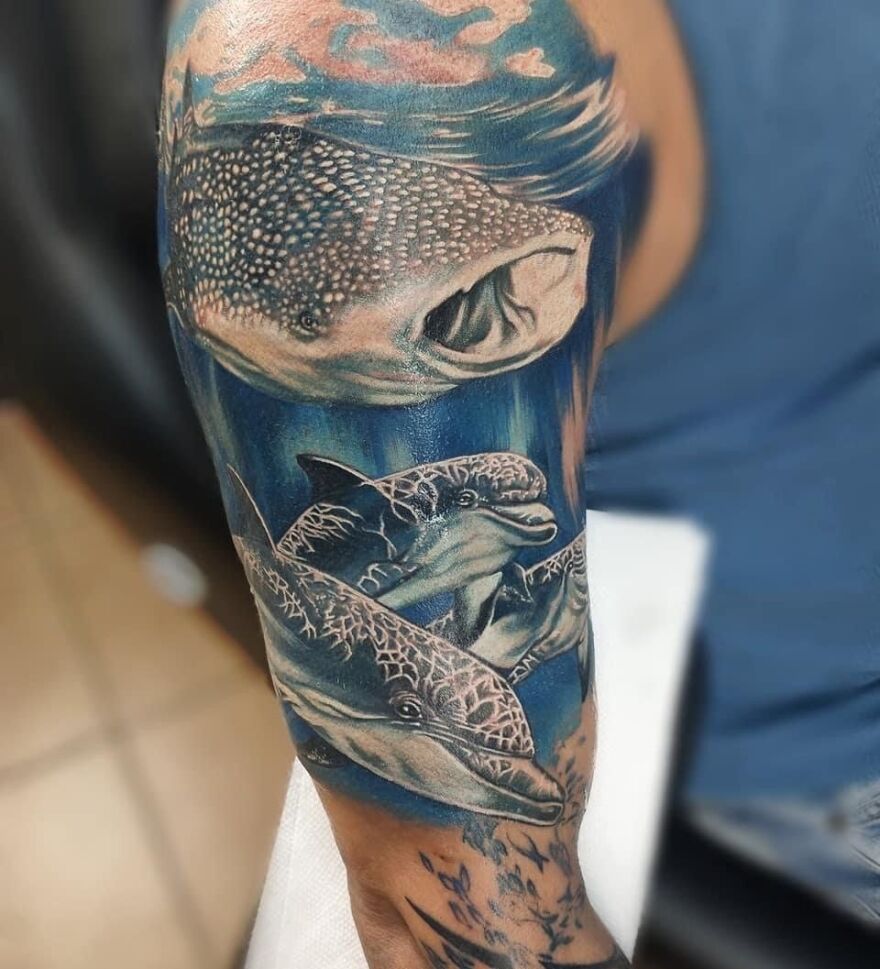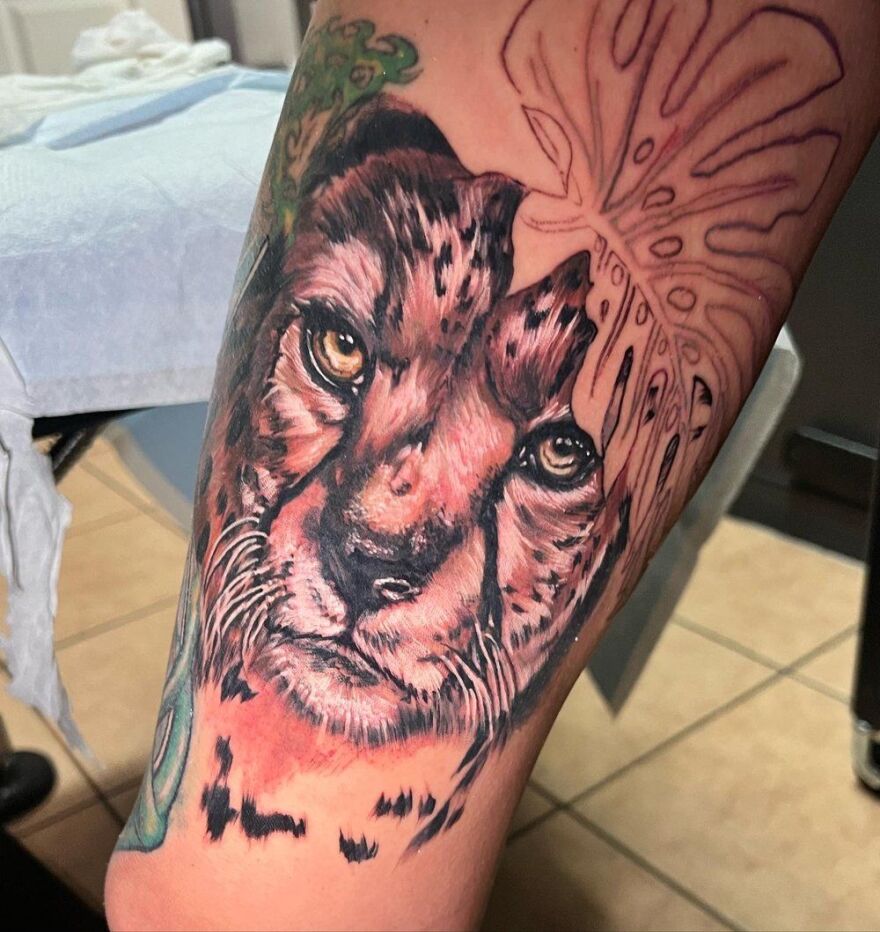Local artist Savannah Leslie has been tattooing for nearly twenty years. Over that span, she’s developed her own unique niche.
“I’m a color artist, predominantly,” Leslie said. “And realism is my favorite, but I never feel like I can quite get into the realm of realism that I want to be in so I end up shooting for the moon and landing among the stars and ending in surrealism.”

Leslie comes from a performing arts background, but she’s become a self-taught visual artist over the years to enhance her tattoo artistry.
“I picked up painting and drawing after I started tattooing in order to improve my ability to tattoo, to take my tattooing from taking something off of the wall to a custom design that someone could come in and it was their own piece that wasn’t duplicated in any way,” she said. “In order to do that, I felt that I needed to get better by using other mediums.”

Her regular clients are evenly divided between men and women. But there is one area that caters primarily to females.
“I have a project called Scars Transformed for over a decade now. Any breast cancer survivors, mental illness survivors, self-harm scarring, all of that I tattoo. In the case of breast cancer survivors, any mastectomy reconstructive tattooing that I do is all free. And I’ve covered up a lot of self-harm scars for free as well.”
For some, tattooing over their scars is about closure. For others, it’s acceptance, and a celebration of survival. Either way, tattooing releases the deep-seated memories and emotions associated with these traumas.
“There’s a large therapy element to what all tattooers do,” Leslie noted. “Even if it’s not a reconstructive or a healing tattoo, they’re all healing in their own way. Pain therapy brings out everyone’s vulnerabilities so they talk to me about things that I don’t think that a lot of people even in their own lives may hear about. I see a lot of tears. There’s a lot of joy. Those are my best days at work. They are foundational to why I do my job now.”
Leslie notes that Scars Transformed is a milestone in a client’s road to recovery that only comes after years of medical treatment and therapy.
“I am an artist. I do like to create big beautiful eye-catching things that make people’s jaws drop, but at the end of the day, the smallest reconstruction is a better day at work than a large back piece.”

MORE INFORMATION:
Savannah Leslie started out pursuing a career in law enforcement.
“I went to school to be a police officer but found it too confining,” said Leslie. “I ultimately knew I would end up doing something that had a certain amount of freedom to it. The arts is the freest thing I can think of.”
She wound up apprenticing at a tattoo studio.
“A lot of the old school studios had flash on the walls.”
Flash are watercolor paintings and drawings of various tattoo designs created by the studio’s artists.
“People would come in and pick their pre-fab design,” Leslie explained. “You would take that and recreate it. There wasn’t necessarily a need a long, long time ago to draw freehand.”

But Leslie saw that the industry was headed in the direction of custom design, so she enrolled in several art classes.
“I’m 100 percent self-taught,” said Leslie. “I’ve taken classes, sort of run of the mill here and there, but no art degrees or anything like that.”
But she did acquire an appreciation of and some acuity in the visual arts.
Leslie works at several locations, including Howl Tattoo Gallery. Like Howl, she keeps tabs on the continual proliferation of tattoo styles. Even though she considers herself primarily a color artist, clients do periodically request designs in other styles.
“There’s black work, fine line, heavy black line,” Leslie pointed out. “It’s all dark and moving. But my clients usually come to me for color, although recently I’ve had a really big resurgence of black and grey clients.”

When someone new schedules an appointment, the first thing Leslie does is sit them down and have them go through her portfolio.
“I feel like every tattoo client should look heavily at an artist’s portfolio,” said Leslie. “I always say pick the worst tattoo in their portfolio, and if you are comfortable with that level of work, then you are going to be happy with whatever you end up getting from that artist. So I will absolutely push my portfolio at anybody who comes in asking for a piece so that they are very familiar with the level of work that they’re receiving, the type of work that they’re receiving and that’s probably one of the most important things about discussing any project with my clients.”
Leslie said that while most of her clients have at least some vague ideas of what they want, they are comfortable leaving the specifics to her. She loves brainstorming about potential designs.
“Those are my most fun clients. Those are the one where I can go, ‘Do you like x, y and z? Because if you like x, y and z, we can blend it with a, b and c and end up with something that’s really crazy.’ Those are the projects that end up going in the portfolio!”
As a predicate to these collaborations, Leslie spends some time getting to know her client’s interests, hobbies and personality.
“I want to know whether they’re more of an adventurous type or someone that’s a bit more reserved. That will help cut out a more clear idea of the type of artwork they ultimately want to end up with.”

Those discussions are deeper and longer for women who come to her to tattoo over medical and self-harm scars.
Leslie emphasized that Scars Transformed clients come to her at the end of their medical treatment or psychological counseling.
“I’m the end of the road of recovery.” Leslie reiterated. “I’m not towards the beginning. There’s a lot of work that goes into stuff before people come to see me.”
Even so, the process of choosing a design and having Leslie imprint it over a mastectomy or self-harm scar is always emotional. The body remembers. Trauma doesn’t just haunt the soul. It lingers in the body, trapped in the musculature. Our "body armor" records the damage inflicted on us, codifying it in the form of tension, inflammation and pain even as our waking minds struggle to forget the causes.
In some cases, many believe, memories of the trauma are repressed, buried deep within the subconscious, where they become disassociated from the physical and psychological scars that remain embedded in the trauma victim’s musculature and nerves. Tattooing over a physical scar can unlock and release these traumatic memories to the same extent and degree as psychological or somatic therapy.
Leslie said she encounters this phenomenon with regularity.
“I wear my job through my own front door,” Leslie admitted. “I kind of have to get home and shake it off some days. It’s rewarding. I do appreciate that what I do is rewarding, but it can be heavy depending on the day and the client and what they’re going through because when you spend anywhere from 4 to 9 hours listening to somebody episodically, you care about those people. Their lives matter to you.”
In spite of the emotional toll, Leslie would like to do more reconstructive tattooing.
“I’ve been trying to have it funded for a really long time. But ultimately I want to build it into a nonprofit. It’s just really, really hard to get there.

"I can give a lot to men and women on their own roads to recovery. It is a driving force to do what I do to help people recover. So what I would want people to know is that if you have need of a service like that, please come see me because it makes my days at work a lot more worthwhile. It makes my contribution to the industry feel like it matters.”

Savannah Leslie trivia: When she was 18, Leslie modeled for the Suicide Girls, “a global adult community with tattooed and pierced models who share nude photos, blogs, livestreams and videos that shine a light on a new female aesthetic.
"Everywhere you look you see the super-thin, super-tall, bleach blond Baywatch babe. There are a lot of people out there who want to see a different kind of beauty. It used to be just the website, but now they have full burlesque troupes, dance troupes and all kinds of stuff like that. It’s just tattooed and pierced models back when models were very clean skinned. They were alternative in a sea of normalcy."
Support for WGCU’s arts & culture reporting comes from the Estate of Myra Janco Daniels, the Charles M. and Joan R. Taylor Foundation, and Naomi Bloom in loving memory of her husband, Ron Wallace.







